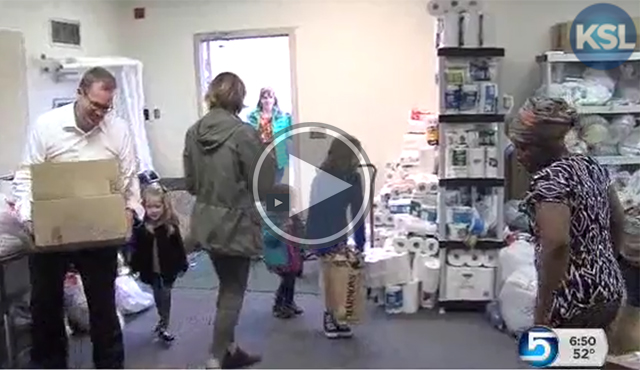She learned about refugees in the LDS Church’s Friend magazine. Then she came up with an idea to help out.

We all know it is better to give than to receive. And, of course, the point of giving to a worthwhile cause is not expecting anything in return. Nevertheless, there are financial benefits to charitable contributions when you file your taxes. Here are a few tips & guidelines regarding taxes and charity.
What Is Deductible?
The IRS doesn’t allow deductions for funds given to specific individuals or families. Meaning, if you give a friend in need some money to help them pay for a medical issue, it doesn’t apply. The contribution has to be to a qualified organization, such as the Red Cross, public schools, churches and many other non-profit organizations. If you have a question a group’s tax-exempt status, contact the IRS online or call 1-877-829-5500.
Keep Detailed Records
If you deduct charitable donations on your return, you’ll need more than just a scribbled note on a napkin. There should be a written communication from the organization, including its name, the date and the amount you contributed. Detailed receipts will ensure you have accurate data and are invaluable in case of an audit.
How Much Can I Deduct?
You can actually deduct up to 50% of your adjusted gross income when it comes to charitable contributions. It’s one of the few itemized deductions that doesn’t have a floor, or lower limit, meaning you get to deduct every dollar that you give to qualified organizations until you reach half of your income level. Every dollar that you donate to charity beyond that 50% of your income will still give you warm fuzzies, but you don’t get to deduct it on your taxes.
It’s Not Just About Money
Cash contributions aren’t the only things that can lower your tax bill. You can also deduct the value of donated clothing, furniture, vehicles and more. To do this right means you have to get a receipt when you donate and determine fair market price of the item — which is, essentially, a reasonable price if you were selling it. There are also cases when you can deduct the cost of travel to and from a place where you volunteer your time, the price of a volunteer uniform and other endeavors.
Please remember that this article is for information only. We recommend consulting your tax advisor with questions regarding specific deductions and charitable donations. However, if you want to start donating today, the America First Community Assistance Program is a wonderful — and tax-deductible — effort you can join. Simply log in to your online banking account and make your contribution.
We gave a High 5 award to a woman who spans the globe looking for opportunities to help people. Not only that, when she’s home here in Utah, she trains man’s best friend with an eye on helping others see.
A broken down car could have easily ruined their Christmas. That appeared to be the case for a Syracuse family when the part their car needed was not in stock at one mechanic’s shop.

St. Valentine’s Day can be a divisive holiday. On one hand, there are couples who have already set up a wedding savings account and love Cupid, flowers, chocolates and romance. On the other hand, there are people who are single and on a budget — who want to mark the occasion, but won’t be spending money on extravagant dates or giant teddy bears. If you’re in the latter group, here are a few ways to enjoy February 14 without breaking any hearts or the bank.
For the Single Ladies
To celebrate girl power and your love for all of your lady friends, “Galentine’s Day,” popularized by the television series Parks and Recreation, is an excellent option. Bust out your favorite pink and red dresses to really get festive. And if you don’t have a cute dress in the right color, visit a local thrift store to find something fun and affordable.
You’ll also want the surroundings to match the festivity. Here are some budget-friendly DIY decoration ideas for your celebration:
- Fringed photo backdrop — cut several large strips of pink, white, and red crepe paper, then trim for a fringed border. Attach one side of each to the ceiling and twist the bottom for a great background for your photos.
- Garland — cut out some felt hearts and hot glue them to a long ribbon or piece of twine. Then you’ll have something to hang over your windows and doorways.
- Hugs & kisses — take a basic red, white or pink cotton tablecloth and use acrylic or fabric paint to draw simple Xs and Os on it.
We all know food can make or break a party. Brunch is great because it’s affordable and easy for everyone to contribute. It doesn’t have to be elaborate or expensive:
- Waffles — this staple is always a favorite. Have everyone bring their favorite waffle topping (whipped cream, chocolate, strawberries, etc.) to save some money.
- Omelets — find items at the supermarket to create an omelet bar. Simple ingredients such as mushrooms, peppers, onions, tomatoes, spinach and cheese are inexpensive, yet delicious.
- Add granola and dried or fresh fruits to a small bowl of yogurt for a hearty and satisfying snack that is also easy on the pocketbook.
You can also gather to binge-watch your favorite chick flicks via streaming services; it’s much cheaper than heading out to the theater. Give each other Valentine’s-themed manicures as you’re watching. Another idea is to end the evening with a lip-sync battle featuring the all-time greatest girl power songs.
For the Single Men
Don’t worry, guys, we didn’t forget about you! This season is also a good time to celebrate your bromance with your friends! Here are some suggestions for you.
Have a tournament. You probably already own most of the necessary equipment, so it shouldn’t cost much. Just print out a bracket, invite some of your guy friends over, pick a team name and show who is the best at:
- Basketball — play three-on-three, H-O-R-S-E, or lightning in your driveway or at a nearby gym or blacktop where you can play for free.
- Football — flag football is fun for large and small teams. You can also search online for pick-up games happening in your area.
- Ping-pong — go one-on-one in single elimination or compete in doubles. Blast the Rocky soundtrack to make it even more epic.
- Foosball — you’ll have to determine if your house rules allow spinning or not, but this is even a crowd pleaser for those who don’t like sports.
- Video games – host a LAN party or dust off your old N64 and play some Goldeneye.
Food is also essential here. Pizza is a good, inexpensive way to feed a large group. Here are some other dishes that you can bring to a bromantic potluck:
- Seven-layer dip — as long as you have beans, sour cream, guacamole and cheese, people usually won’t count the actual layers. Don’t forget the chips!
- Pulled pork — shoulder (or Boston butt) roast usually goes for about $2 a pound. Watch store prices and buy when it’s on sale.
- Hot dogs — add some diversity to your dogs with inexpensive toppings such as ketchup, mustard, Dijon mustard, pickles, relish, onions, sauerkraut, chili, banana peppers and BBQ sauce.
So instead of feeling sad or lonely on Valentine’s if you’re single, have some fun with your friends and do it without spending too much.
The FOX5 Surprise Squad delivers a 30-minute special featuring the biggest surprises and follows up on families like the Chili’s waitress who received a $12,000 tip from the Squad. This heartwarming show packs a powerful dose of feel-good and inspirational stories. Hosted by FOX5’s Monica Jackson and Cassandra Jones.

Have you ever taken a break from spending money? If so, for how long? One or two days? Three? What if we told you that it’s possible to not spend money for an entire week? Of course, everyone’s financial situation is different, but if you’re up for the challenge, here’s how to complete your seven-day spending freeze.
Prepare
First, choose your starting date and mark it on your calendar. If you don’t know what your weekly budget is, track your spending for a few weeks beforehand. This will give you an idea of how much you can save and it will make you more aware of unnecessary spending.
Just before you begin your freeze, gas up your car and go grocery shopping. Plan a menu for the week and only buy what you’ll need. Don’t stock up on excessive amounts of food the day before — that would defeat the purpose of this exercise. Your goal is to use what you have for the next seven days.
Exclusions & Exceptions
Your monthly bills need to be kept current, so make sure to take care of those. If possible, choose a period when you don’t have to pay any reoccurring payments. Additionally, you should always pay the necessary costs of emergencies (basement flooding, broken bones, alien invasion, etc.) and move your spending freeze to another time, if necessary.
Next, set aside your estimated weekly budget and put those funds in a separate account such as money market savings. This will be your backup fund, but otherwise it is off limits. And now, with your gas tank full, your refrigerator full, your bills paid and your money set aside, you are ready to begin.
Get Going
Spend each of the seven days using what you already have. Follow your meal plan, pack lunches from home and don’t stop for fast food on the way home from work. You may even have unexpected leftovers from dinner that can double as lunch for the next day — which will extend the life of your pantry supplies.
Try to avoid unnecessary travel during this week. Oftentimes, we don’t think about the gas we use when we’re out and about. If you can, walk or use a bicycle to run errands. And instead of driving to the city to see a movie, for example, watch something at home that you already own. It’s perfectly acceptable to be a homebody during your freeze.
Follow Up
You did it! And you now have a full week’s budget available to pay off debt, complete a home repair, or put toward a long-range goal. Resist the urge to spend your newfound funds on something frivolous. Keep increasing your savings to you can make your money work harder.
Spending freezes are like juice cleanses — they should be done in moderation. But if you were able to handle a week, you might want to consider periodic freezes several times throughout the year and use the money to make deposits in an America First dedicated savings account for future needs. You’ll be surprised how quickly your financial resources grow when you’re not spending them.

Cybercriminals & their schemes, which seek to rob you of your resources, seem to proliferate during tax season.
The Internal Revenue Service is warning consumers that several threats have been reported across the country. Being aware of them and maintaining vigilance in protecting your personal data is always essential, no matter the time of year.
Here are some examples of recent scams:
- Identity thieves sent phishing emails to tax preparation firms. The messages purported to come from a company human resources executive, requesting employees’ W-2s. Never provide your personal information to anyone but your trusted tax advisor if you hire someone to do your filing.
- Taxpayers have been victimized over their returns. One instance involved a scammer submitting fraudulent refund claims using another person’s identifying information, which had been stolen. This caused considerable delays in refunds.
- Cheats pose as IRS officials and request sensitive information via email or text. The IRS will never contact a taxpayer through these methods and ask for this data. Also, don’t click on any link or attachment in a suspicious email.
And here are some additional tips to help prevent being victimized:
∙Don’t carry your Social Security card or any documents with your number written on it.
∙Check your credit report at least every 12 months, if not more frequently.
∙Secure personal information in your home.
∙Protect your computers & devices with firewalls, anti-spam/virus software, and updated security patches.
∙Go to this link to learn how we are working to safeguard your finances.

Are you preparing to become a stay-at-home parent, dealing with a recent layoff or saving up for a big purchase? Even though it may sound impossible, you can live on only one income and make it work.
Whether you’re single or married, have children or not, these three simple ideas are essential: create a plan, spend less and save more.
Before you think that sounds too easy, let’s break down the specifics:
Create a Plan
Successful single-income families don’t just happen — they require a strategic evaluation. First, create a realistic budget to better manage your money and stick to it. If you need to review it later on, that’s fine, but be sure to get off on the right foot.
Next, stay on top of your bills. Ensure your regular financial obligations are a priority so you don’t end up paying any unnecessary fees or fines. You can also focus your efforts on paying off debt initially, which will free up resources later.
Finally, if you have too many credit cards and loans to keep track of, consider consolidating them at America First. Our low rates and flexible terms will help you save time and money. Plus, having all of your loans in one place will require significantly less mental effort.
Spend Less
If you are moving from multiple incomes to a single income, you’re going need to make significant financial changes. Don’t try to maintain the lifestyle you had with two incomes. Instead, try to make spending sacrifices — such as buying generic instead of brand-name products, or scaling back a planned vacation. It’s much easier to save more when you spend less.
And when it comes to shopping, determine if you really need to go at all. Can you put together some meals using what’s already in your pantry? Do you really need a new pair of shoes? When you head out, always look for the best deal and use coupons or discount codes.
Also, take a look at your housing situation. If necessary, consider moving into a more affordable living space, or refinancing your mortgage to a lower rate. If you already have a reasonably priced home with affordable monthly payments, fix things yourself instead of immediately calling a professional.
Save More
Even though you’ll be cutting down on what you spend as a one-income family, you should still regularly save. A rainy-day fund can give you peace of mind if any unexpected expenses or emergencies pop up. America First has just the right tool to help you set aside some funds, too — dedicated savings accounts, which provide competitive dividends on automatic transfers that you can set up.
Additionally, you can actually save money by not working. If just one of you is going to the office every day, that means only one vehicle is commuting — set aside what you used to spend on gas and upkeep. Those at home will also eat out less than someone at an office and the entire family should do the same — leftover food helps create leftover funds.
Whether your single-income status is temporary or permanent, this advice applies for the short term and the long haul. Making a plan, spending less and saving may seem intuitive — because they are. It’s very similar to the “secret trick” to losing weight: diet and exercise. However, putting these principles first, discussing your strategies and writing things down can truly make a difference.







 By Glen Olpin, Senior Vice President/Chief Economist
By Glen Olpin, Senior Vice President/Chief Economist